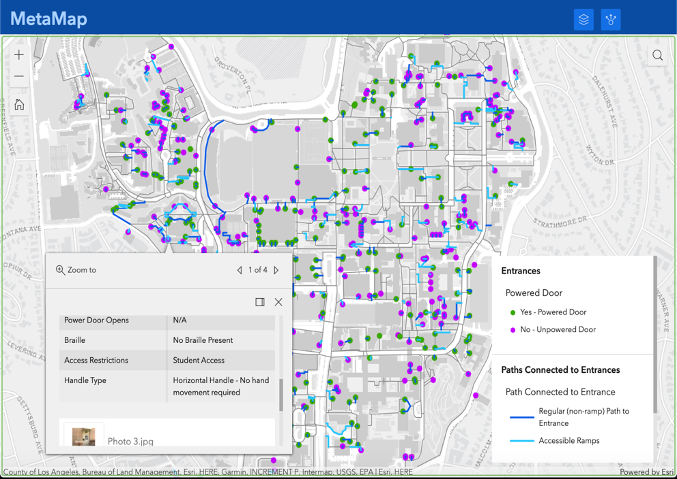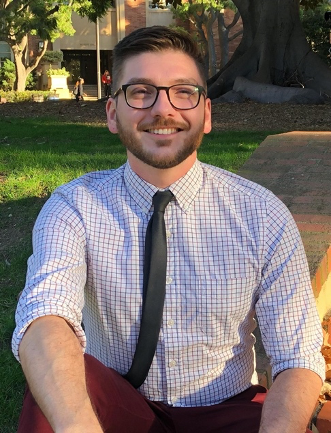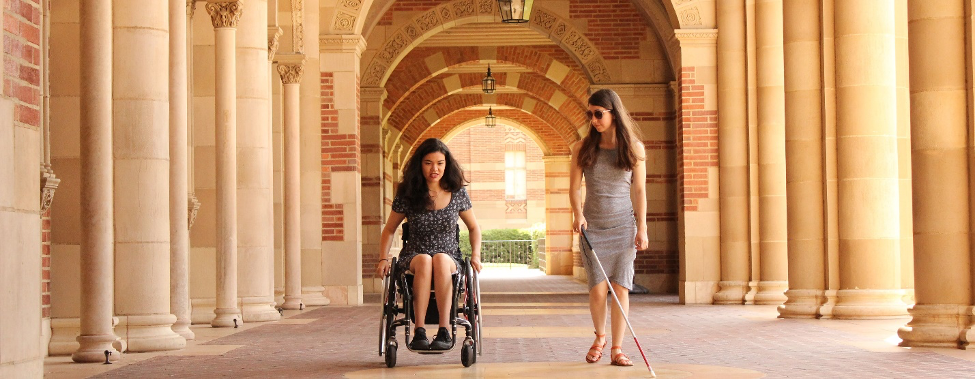By Heather Chou, Sean Woodward, and Carolanne Link. If you’ve had the pleasure of getting to the UCLA campus this year, you may have taken note of just how difficult it can be to navigate. Even beyond the regular confusion of “Zero Week” before fall quarter begins, finding the best way through campus is often a struggle. This challenge can be especially difficult for Bruins and others who navigate campus with unique mobility considerations.
Ever wondered how, if you were using a wheelchair, you could get around Janss/Tongva steps, the lengthy staircase that is the main access point to North Campus? What if you were not able to see? The answers are vital to many Bruins returning to campus. But the rich and easily accessible data that students expect in order to find those answers are not currently available. That is where MetaMap comes in.
MetaMap is a group of UCLA students and staff who have come together to “put disability on the map” and make campus a more accessible place for all. Our goal is to assist our disabled community members by moving UCLA into the future of accessibility. We are doing this by working to replace the university’s outdated, static, PDF map of the campus’ accessibility features.
Instead, we are creating an updated and interactive accessibility dataset to ensure disabled community members have all the information they need to safely and comfortably traverse UCLA. It’s a big goal, but we are well on our way to making it a reality.
 This past spring, the team took a major step forward with help from the Office of Equity, Diversity & Inclusion (EDI). EDI invested $8,000 in the MetaMap team for the creation of an accessibility focused dataset of every exterior entrance, entrance path, and ramp on the UCLA campus.
This past spring, the team took a major step forward with help from the Office of Equity, Diversity & Inclusion (EDI). EDI invested $8,000 in the MetaMap team for the creation of an accessibility focused dataset of every exterior entrance, entrance path, and ramp on the UCLA campus.
When we set out to put these funds to work, we didn’t just want to know where the entrances were. We also wanted to know everything a person with different mobility concerns might need to know about them. Any student might have a huge variety of mobility considerations. While wheelchair access is one of the most obvious, there are also considerations for dexterity, stamina, vision, and much more.
We wanted to bring people to the table who have experienced accessibility barriers on campus to help us ask the right questions. Does the door have a powered operating mechanism, or does it need to be opened manually? If so, what type of handle opens the door? Is the door signage marked in Braille? Is that Braille accurate and undamaged? There were so many questions to consider. Through conversations with community members, we developed over a dozen questions to ask about each entrance, the answers to which aid in making effective navigation decisions. With this framework in hand, the team hit the pavement to create the dataset and moved one step closer to an increasingly accessible campus.
Using Geographic Information Systems (GIS) to turn our phones into mobile data centers, the team digitized, photographed, and recorded thousands of pieces of information about the campus. In just the few short months of the Spring 2020 quarter, the team created a one-of-a-kind dataset of over 530 doors and 140 ramps. The data were then integrated into an interactive and user-friendly web app, making the campus easier to navigate for all Bruins.
But accessibility considerations didn’t just stop at the entrance data we collected. We also considered red-green color blindness and low vision contrast when picking the colors on our map. Furthermore, we posted the raw accessible entrances dataset for people who find that a more accessible option. Our web app, with the accompanying dataset, is a starting point for even greater things to come.
With this rich accessibility dataset, we hope not only to empower UCLA’s community of disabled students, faculty, staff, and visitors, but also to prepare the campus for the 2028 Los Angeles Paralympics (LA28). Currently, the LA28 Paralympic Village is expecting to host approximately 8,000 athletes, coaches, and support staff at UCLA. Of these 8,000 individuals, approximately 25% are projected to be wheelchairs users and 10% individuals with visual impairments, just to name a few demographics we will be serving. This may seem nearly impossible, given the lack of accessible resources and spaces for even UCLA students. But MetaMap may be a fabulous boon for our visitors in 2028!
Although MetaMap is still in its early stages, the accurate and disability-aware elements of this map seek to empower the disabled community in the physical spaces of UCLA. How awesome would it be to have a phone or computer app right at your fingertips that considers the needs of users with disabilities and provides them with more personalized routing around campus? Our team’s long-term dream is to transform our current path and entrance dataset into a complete navigation system for turn-by-turn directions, like a disability-friendly GPS for UCLA!
As MetaMap progresses into new projects and aspirations, we continue to keep focus on the overarching goal of this project: serving and empowering our disabled community members. As a team of students and staff working together to build a more accessible environment, it is critical for us to maintain inclusion in all possible spaces, whether physical or on the web (and the intersection of both!). As we watched the Tokyo Paralympics conclude, we took with us their resounding message of the #WeThe15 disability rights movement that disability rights are human rights.
MetaMap aims to show not just how UCLA’s campus can improve its accessibility efforts and resources, but also how UCLA has the potential and opportunity to become a world leader in inclusive and accessible spaces for people with disabilities, especially as LA28 approaches. As MetaMap continues to grow and evolve, our team hopes that this resource can inspire others to take action and care about making our world more accessible for everyone.
 Heather Chou is a 3rd year student at UCLA majoring in Geography and double minoring in Geographic Information Systems & Technology (GIS&T) and Public Health.
Heather Chou is a 3rd year student at UCLA majoring in Geography and double minoring in Geographic Information Systems & Technology (GIS&T) and Public Health.
 Sean Woodward (‘20) graduated with a double major in Geography and Environmental Studies and a minor in Geographic Information Systems & Technology (GIST).
Sean Woodward (‘20) graduated with a double major in Geography and Environmental Studies and a minor in Geographic Information Systems & Technology (GIST).
 Carolanne Link is a disabled UCLA alumnus and the Disabilities and Computing Program & UCLA Web Accessibility Initiative Project Manager, and the Disabilities Lead for the MetaMap Project.
Carolanne Link is a disabled UCLA alumnus and the Disabilities and Computing Program & UCLA Web Accessibility Initiative Project Manager, and the Disabilities Lead for the MetaMap Project.

